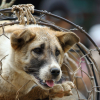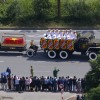Associate Professor Tien Huynh from the School of Science, RMIT University in Australia, and her colleagues are working on a study on farming on the moon.
She herself plays a key role in selecting plants and analyzing plant growth parameters in the Australian Lunar Experiment Promoting Horticulture (ALEPH) project, which is led by local space start-up Lunaria One and supported by the Australian National University (ANU).
The ANU said: “ALEPH will be the first in a series of experiments to investigate whether plants can not only tolerate but thrive on the lunar surface.
“The researchers hope the lessons learned from this mission will help unlock new methods to boost sustainable food production on Earth and bolster food security in the face of climate-driven weather disasters.”
The mission is an international collaboration between a number of institutions, including the Queensland University of Technology, RMIT University, ANU, and Israel’s Ben Gurion University, it said.
The plants to be sent to the moon will be carefully selected based on how quickly they germinate and their tolerance to extreme temperature swings experienced in space.
One of those considered is rapeseed (Brassica napus), a plant with yellow flowers from which an edible-industrial oil is extracted.
“Preliminary results suggest this could be a good candidate as far as extreme temperature tolerance and germination speed for surviving a mission to the moon or Mars,” Tien was quoted on in a report on the university’s website.
Speaking to VnExpress, Tien said some plants do not grow normally if gravity changes, but researchers have not fully found out why.
The moon has a harsh environment with a thin atmosphere, enormous temperature fluctuations and poor soil, which means only robust plants could survive there, she said.
The researchers have tested more than 11 plant species, including resurrection plants (species that can survive dehydration for months, losing most of their cellular water, and quickly resume normal physiological activities after rehydration) and those identified as fast germinating, she said.
“Rapeseed is chosen as its germination rate is more than 95% within 12 hours after a freeze-thaw cycle.”
Tien is an expert in the conservation of endemic species, environmental sustainability and upcycling, plant pathology and mycorrhizal symbiosis, biocomposite engineering, medicinal plants against cancer, diabetes and neurodegeneration.
She also studies plants’ speed of germination and survivability.
“We are testing substrates for plant growth as well as packaging and protecting the seeds sustainably. After that, we’ll work with engineers to optimize the sensors used for checking the development of plants.”
Dr. Graham Dorrington from the School of Engineering at RMIT University Australia and co-founder of Lunaria One, said seeds and plants would be packaged in a sealed chamber with a special design and equipped with sensors, water and camera. The chamber is scheduled to be sent to the moon in 2026.
“Our major challenge is designing the chamber to maintain suitable conditions to permit germination on the lunar surface, where the external surface temperature fluctuates from highs of 80°C to lows of –180°C,” he was quoted in a report on the university’s website.
The chamber should not be heavier than 1.5kg and be able to function normally with minimum energy, and at the same time transmit data to Earth at a speed of below 40 kilobits per second.
After landing on the moon, the growth and health of plants will be monitored and data and photos will be sent back to Earth.
Finding out whether plants can be grown on the moon has always interested biologists.
Dr. Ian Burnett, vice president of RMIT University, said interdisciplinary research could provide valuable knowledge to support farming in places with harsh climates on Earth.
The moon project began in September 2021 and will wrap up in March 2026.
The Australia Space Agency has provided AUD3.6 million (US$2.4 million) for it.
- Reduce Hair Loss with PURA D’OR Gold Label Shampoo
- Castor Oil Has Made a “Huge” Difference With Hair and Brow Growth
- Excessive hair loss in men: Signs of illness that cannot be subjective
- Dịch Vụ SEO Website ở Los Angeles, CA: đưa trang web doanh nghiệp bạn lên top Google
- Nails Salon Sierra Madre
 VnExpress News The News Gateway of Vietnam
VnExpress News The News Gateway of Vietnam





